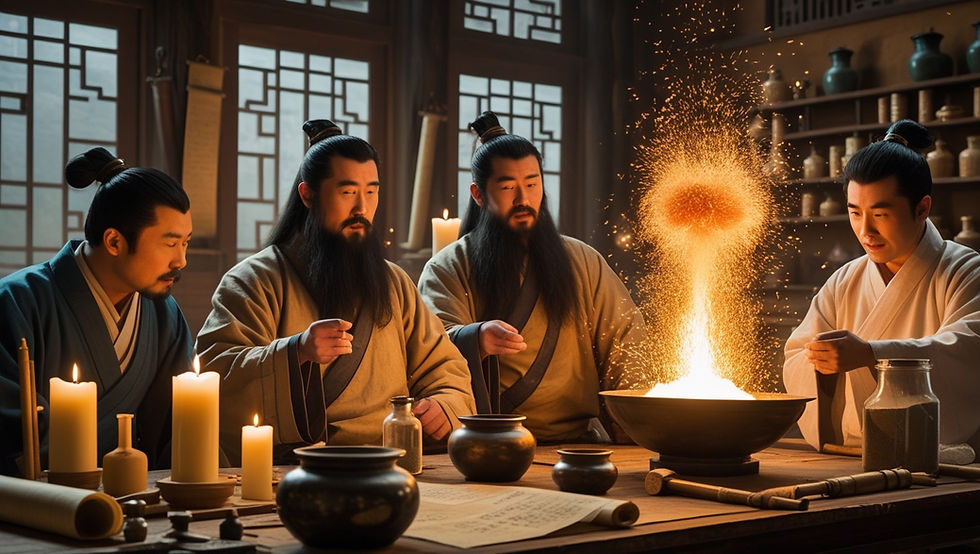Gunpowder: The Explosive Invention
- Maria Hasan
- May 13
- 3 min read
Updated: May 21
Throughout human history, wars were fought with swords, arrows, and the strength of armies in close combat. But one invention changed all that—gunpowder. What started as an accidental discovery by Chinese alchemists eventually became one of the most important and disruptive technologies the world has ever seen.
The arrival of gunpowder didn’t just change the way battles were fought—it helped build empires, triggered revolutions, and altered the course of history. From fireworks to firearms, gunpowder set the world on fire—literally and figuratively.

The Origins: Alchemy Meets Discovery
Gunpowder was first invented in 9th-century China, during the Tang Dynasty. Alchemists were searching for a potion to achieve immortality—but what they discovered was something far more volatile. They mixed saltpeter (potassium nitrate) with charcoal and sulfur, and found that the mixture produced violent, fiery reactions when exposed to flame.
These early experiments resulted in the first version of gunpowder—known as “black powder.” Initially, it was used for fireworks in religious and celebratory events, with bright displays intended to ward off evil spirits. But soon, its explosive potential was recognized for military use.
By the 10th century, Chinese inventors had begun using gunpowder in warfare, developing fire arrows, smoke bombs, and basic grenades. They even created “fire lances”, which were early flamethrowers combining gunpowder with a spear-like weapon.
From East to West: The Global Spread of Gunpowder
Gunpowder didn’t remain a Chinese secret for long. Thanks to trade along the Silk Road and the expansion of the Mongol Empire, gunpowder technology spread westward. By the 13th century, the knowledge had reached the Middle East and Europe.
In the Islamic world, scholars and engineers quickly began experimenting with gunpowder in military applications. Manuscripts from the medieval Arab world describe early versions of hand cannons, mines, and rocket-like devices.
When gunpowder reached Europe, it dramatically altered the battlefield. The once-impenetrable walls of castles crumbled under the force of cannons. Infantry soldiers began trading swords for muskets, giving rise to new forms of organized warfare.
What followed was a military revolution that not only redefined combat but also reshaped the very structure of governments and societies.

Gunpowder Empires: Power Through Fire
The rise of “Gunpowder Empires” in the early modern period demonstrated just how transformative this invention was.
The Ottomans used cannons to breach the mighty walls of Constantinople in 1453, bringing an end to the Byzantine Empire.
The Safavids in Persia relied on gunpowder artillery to defend and expand their territory.
The Mughals in India used advanced weaponry to conquer vast regions, establishing one of the most powerful empires in South Asia.
In Europe, gunpowder helped shift power from feudal lords to centralized monarchies. Kings and queens who could afford gunpowder weapons were able to raise large standing armies, enforce laws more effectively, and suppress rebellions with overwhelming force.
The balance of global power started to shift dramatically, and gunpowder was at the heart of it.
A New Kind of Warfare
With the arrival of gunpowder, everything changed:
Castles and fortresses lost their strategic advantage. Walls that had stood for centuries could now be destroyed in days.
Armies grew larger, and battlefield formations became more complex, with gunners, pikemen, and cavalry working in coordination.
Naval warfare was transformed by ships equipped with rows of cannons, leading to the age of gunpowder-fueled empires at sea.
Warfare became more mechanized, less reliant on personal strength and bravery, and more dependent on strategy, resources, and technology.
But the impact wasn’t limited to the battlefield. Gunpowder’s rise also triggered changes in society:
Governments began to invest in military technology and weapon manufacturing.
Wars became more costly, leading to the creation of tax systems, bureaucracies, and national banks.
Cities were redesigned with bastions and star forts to withstand cannon fire, changing urban landscapes across Europe and Asia.

Legacy: Beyond the Battlefield
While gunpowder is most famous for its role in warfare, it also had a powerful impact in industry and culture. In mining, gunpowder helped workers blast through rock more efficiently. In construction, it accelerated large-scale projects by clearing land or demolishing obstacles.
And of course, it continues to be used in fireworks, which have become a universal symbol of celebration.
Modern explosives and firearms have far surpassed traditional gunpowder in power, but the principles it introduced—controlled explosions, projectile motion, and strategic firepower—remain the foundation of military and industrial technologies.
Final Thoughts: From Spark to Strategy
Gunpowder began as an alchemical mistake and grew into a force that shaped the destiny of nations. It ended the era of knights and castles, gave rise to global empires, and forced humanity to rethink how conflicts were fought.
Its influence is still felt today—in defense systems, mining operations, and even in the colorful fireworks that light up our skies. Gunpowder is a reminder that a single discovery can ignite a global transformation.






Comentarios